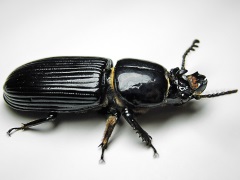Features
With the beetles
Date: 2019-03-15 11:31:19.0
Author: Jon Evans

Long-horned passalid beetle (Odontotaenius
disjunctus).
Image: Wikimedia Commons.
Scientists have analyzed the guts of many plant-eating animals, looking for enzymes and microbes that can break down plant biomass, which might prove of use for producing biofuels. But they’ve paid much less attention to the precise anatomy of the guts and how the enzymes and microbes are arranged within them.
Now, a team of US scientists led by Eoin Brodie at Lawrence Berkeley National Laboratory (Berkeley Lab) has shown that this anatomy and arrangement is critical for the efficient conversion of wood into useful chemicals, at least in a species of beetle. But they think that what works for a beetle could also work for the production of biofuels and biochemicals, leading to more efficient processes.
Brodie and his team investigated a species of beetle known as the long-horned passalid beetle (Odontotaenius disjunctus). Found in forests across much of the world, this beetle feeds on decaying wood, which is both hard to digest and also poor in nutrients. Nevertheless, as well as meeting its own energy requirements from consuming the decaying wood, adult beetles feed their young on the waste material they excrete, termed frass. Studies show that this frass is a surprisingly nutrient- and energy-rich substance, indicating that the beetle has a pretty impressive digestive system to be able to produce it from decaying wood.
This digestive system is known to comprise four distinct compartments, which Brodie and his team decided to investigate in more detai. This included studying their anatomy, identifying the microbes they place host to and analyzing the compounds produced in them. As the scientists report in a paper in Nature Microbiology, each compartment turned out to have a unique anatomy that encouraged the growth of specific microbes with specific abilities.
For example, the midgut is supplied with oxygen by tracheal tubes, encouraging the growth of aerobic microbes that can oxidize lignin and break down cellulose into simple sugars. In contrast, the anterior hindgut has a thick cell wall that restricts the diffusion of oxygen, creating an anaerobic environment that encourages the growth of microbes that ferment the simple sugars into useful chemicals such as acetate.
"It turns out that the beetle's gut architecture, such as the length and thickness of its gut walls, has evolved to suit its microbiome so that specific metabolic processes are favored in different gut regions," explained team member Javier Ceja-Navarro from Berkeley Lab.
This arrangement means decaying wood is broken down and transformed in successive stages as it travels through the four compartments, allowing the beetle to extract as many useful chemicals from the nutrient-poor wood as possible. To aid this process, the thick cell wall of the anterior hindgut also stops useful gases generated during the digestive process, such as hydrogen and nitrogen, from escaping. The excess hydrogen promotes the formation of acetate during fermentation, while the nitrogen helps to make the frass nutrient rich.
"One of the first things we noticed was how much nitrogen the frass contained, three times more than the wood the beetle consumed – this meant the beetle, or actually its microbes, were adding nitrogen," said Ceja-Navarro.
Another recent study indicates that other beetles may take advantage of a similar arrangement. In a paper in Biotechnology for Biofuels, Yaojun Yang and his colleagues at Leshan Normal University in China describe investigating enzymes in the gut of the bamboo weevil Cyrtotrachelus buqueti that are responsible for breaking down bamboo. They found that different parts of the gut play host to a different mix of enzymes, with cellulose-degrading enzymes most active in the midgut and lignin-degrading enzymes most active in the hindgut.
These findings suggest that a similar arrangement might prove beneficial for the production of biofuels and biochemicals, with plant biomass passing through successive bioreactors containing different microbes and enzymes under different conditions.
The views represented here are solely those of the author and do not necessarily represent those of John Wiley and Sons, Ltd. or of the SCI.
Displaying 2 keywords used to tag this article:
- Jules Audemars-Australia Best Quali
- DG6582 Mens Moncler Down Jackets Gr
